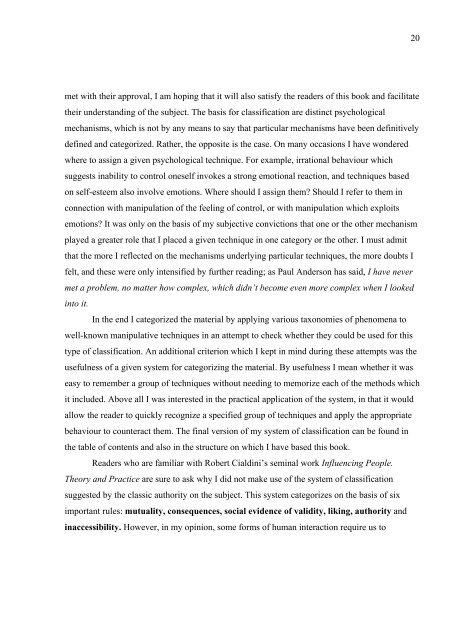PSYCHOMANIPULATION - Tomasz Witkowski
PSYCHOMANIPULATION - Tomasz Witkowski
PSYCHOMANIPULATION - Tomasz Witkowski
Create successful ePaper yourself
Turn your PDF publications into a flip-book with our unique Google optimized e-Paper software.
met with their approval, I am hoping that it will also satisfy the readers of this book and facilitate<br />
their understanding of the subject. The basis for classification are distinct psychological<br />
mechanisms, which is not by any means to say that particular mechanisms have been definitively<br />
defined and categorized. Rather, the opposite is the case. On many occasions I have wondered<br />
where to assign a given psychological technique. For example, irrational behaviour which<br />
suggests inability to control oneself invokes a strong emotional reaction, and techniques based<br />
on self-esteem also involve emotions. Where should I assign them? Should I refer to them in<br />
connection with manipulation of the feeling of control, or with manipulation which exploits<br />
emotions? It was only on the basis of my subjective convictions that one or the other mechanism<br />
played a greater role that I placed a given technique in one category or the other. I must admit<br />
that the more I reflected on the mechanisms underlying particular techniques, the more doubts I<br />
felt, and these were only intensified by further reading; as Paul Anderson has said, I have never<br />
met a problem, no matter how complex, which didn’t become even more complex when I looked<br />
into it.<br />
In the end I categorized the material by applying various taxonomies of phenomena to<br />
well-known manipulative techniques in an attempt to check whether they could be used for this<br />
type of classification. An additional criterion which I kept in mind during these attempts was the<br />
usefulness of a given system for categorizing the material. By usefulness I mean whether it was<br />
easy to remember a group of techniques without needing to memorize each of the methods which<br />
it included. Above all I was interested in the practical application of the system, in that it would<br />
allow the reader to quickly recognize a specified group of techniques and apply the appropriate<br />
behaviour to counteract them. The final version of my system of classification can be found in<br />
the table of contents and also in the structure on which I have based this book.<br />
Readers who are familiar with Robert Cialdini’s seminal work Influencing People.<br />
Theory and Practice are sure to ask why I did not make use of the system of classification<br />
suggested by the classic authority on the subject. This system categorizes on the basis of six<br />
important rules: mutuality, consequences, social evidence of validity, liking, authority and<br />
inaccessibility. However, in my opinion, some forms of human interaction require us to<br />
20


